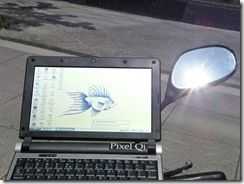 While Intel, AMD, ARM and VIA might want you to believe that low-power silicon is the answer to all battery life problems, the truth is somewhat different. We’re at a point now where all silicon, be it X86 or RISC-based, can perform at low enough power consumption that other components on a device become more significant in the power, heat and battery life equation. Talk about ‘Ãdle’ power drain is irrelevant when you’re using a device in constantly-connected mobile computing scenarios.
While Intel, AMD, ARM and VIA might want you to believe that low-power silicon is the answer to all battery life problems, the truth is somewhat different. We’re at a point now where all silicon, be it X86 or RISC-based, can perform at low enough power consumption that other components on a device become more significant in the power, heat and battery life equation. Talk about ‘Ãdle’ power drain is irrelevant when you’re using a device in constantly-connected mobile computing scenarios.
Two of the main power problems are the wireless radios (chattery 3G transmissions being a huge problem) and the screen. Despite improvements in backlight technology, a small 3.5 inch LCD screen still takes about 0.5 watt when fully backlit. A 10 inch netbook screen will take up to 3 watts. If you’re just reading text, that backlight is taking way over 50% of the total battery drain and as we move to lower-power silicon platforms, the percentage rises higher. This is a particular problem for mobile users as we tend to moving about in different lighting situations and tend to pump the backlight up higher than desk-bound users.
One of the solutions that many have been watching closely for the last year is the technology developed by Pixel Qi. The trick they use is rather simple. They reflect ambient light back through the LCD matrix to reduce the need for backlight. This works indoors and out. The implementation more complex than that of course but the result is that in bright ambient light situations, you will see a big reduction in backlight power drain. The contrast and pixel density is also said to produce e-ink style results too so it could help to make screens more comfortable to read. Pixel Qi have even kept the process fairly cheap to implement by using existing technologies. Win win win!
Screens up to 10 inchare going into mass production right now and we should see the first devices before the end of the year. Expect products to reach customers in 3-6 months based on the time it usually takes new products to reach the market. As for prices, I’m guessing the marketing teams will use this to throw another $50 on a standard netbook price for a ‘sunlight readable’ version but overall, you should see about 10-20% improvement in battery life on a standard netbook. As we move forward with lower power platforms and radios, the advantage goes up and I see this sort of technology becoming the norm rather than something that is offered as a premium upgrade.
I’m looking forward to testing out a nice thin 7 inch ultra mobile PC with this tech. Not that I need to read for 7-10 hours between charges but keeping that battery over 50% full always gives one a better feeling when mobile.











Do they make a multi-touch version of those screens ? I keep thinking they are probably the only way Apple could justify the high price they probably want to charge for their upcoming tablet.
Mulitouch is a separate layer that has nothing to do with screen production, it’s developer dependent process. Apple has no justification to charge premium if it will have this screen because –everyone– will have this screen as an option for the reason that this is mass produced item and not something super expensive to make.
the manufactures will just start using smaller batteries too pad profit margins & we will be right back in the same situation.
Here is what Jepsen is complaining about:
“MobileMark seems to (according to our laptop-making customers) require that we also crank the backlight up for the power measurements to the same level as other screens that aren’t reflective and in fact are hard to read even at 60 nits backlit brightness in roomlight – this even though with no backlight the Pixel Qi screen can exceed 60 nits of brightness without any “wash-out†or annoying glare.”
http://www.pixelqi.com/blog1/
I like very much the sunlight readable part :)
>go to Mass Production
There is no new info on their site.
http://www.pixelqi.com/
only new pictures on blog:
http://www.pixelqi.com/blog1
Pixel Qi comienza la producción en masa de sus pantallas de bajo consumo – http://bit.ly/7ybgcu – Competencia para la tinta-e en e-books.
With ARM processor and Pixel Qi, the 3-cell Laptop will last 30 hours on a battery, while the similar Intel powered one will last less than 10 hours.
So your processor power consumption thing is not really true.
With Pixel Qi, the power consumption of the processor becomes the absolute biggest factor of the device. Especially also while DCON process (where the processor down-clocks itself to zero when unused) is easier to implement with ARM than X86.
quote
“So your processor power consumption thing is not really true.
With Pixel Qi, the power consumption of the processor becomes the absolute biggest factor of the device. Especially also while DCON process (where the processor down-clocks itself to zero when unused) is easier to implement with ARM than X86.”
unquote
It true if you don’t have the Pixel Qi display, which I think is what the article was saying.
I enjoyed reading your article.